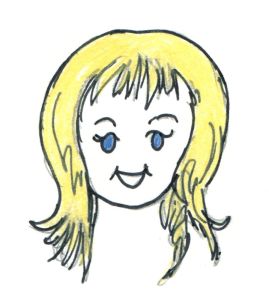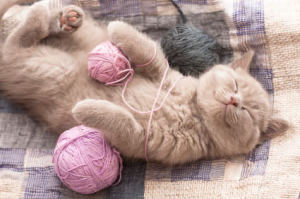Samantha: Our Feelings Girl
 “Hi, I am Samantha and I am friends with Henry, Amanda, Larry & Gary, Gerald and the rest of our gang. We have lots of fun together.
“Hi, I am Samantha and I am friends with Henry, Amanda, Larry & Gary, Gerald and the rest of our gang. We have lots of fun together.
I am the feelings girl and that means that I honor and express my feelings and I am very grateful to have them. I also help my friends notice what they are feeling and help them figure out how to relate to them.
 I have a new kitty Ruby and she is so silly. She makes me laugh, so that means she makes me happy. She loves to play with yarn, chase butterflies and sniff the grass outside in the yard! Can you believe she sniffs grass? Maybe she learned to do that from Henry’s bunny Charlie or Larry and Gary’s puppy Max. I’m not sure, but it is really funny. I had a good feeling about getting Ruby and I was right!
I have a new kitty Ruby and she is so silly. She makes me laugh, so that means she makes me happy. She loves to play with yarn, chase butterflies and sniff the grass outside in the yard! Can you believe she sniffs grass? Maybe she learned to do that from Henry’s bunny Charlie or Larry and Gary’s puppy Max. I’m not sure, but it is really funny. I had a good feeling about getting Ruby and I was right!
My cousin is Thomas, who you haven’t met yet. You will meet him next time. He is in charge of making the right decision, being safe and using good judgment. You can see why we are cousins.
I am writing in my journal. I love writing in it. It gives me permission to let my feelings show without thinking about how anyone else feels. That is really important. My journal is pretty. It’s purple and bright pink with a lighter pink heart.
I have to go now. That Ruby, I think she just got into my box of crayons. I wonder what she will do with those? Bye for now!”
Laymen’s Terms
We need to standardize the meanings of a few words before we begin to explore how our emotions affect our feelings, desires and moods.
Emotions: The brain interprets external stimuli and generates automatic and unconscious emotional responses to these stimuli.
Feelings: These happen when we become aware of our emotional responses.
According to Scientific American, “When we are afraid of something, our hearts begin to race, our mouths become dry, our skin turns pale and our muscles contract. This emotional reaction occurs automatically and unconsciously. Feelings occur after we become aware in our brain of such physical changes; only then do we experience the feeling of fear.”
Feelings include those of the body and of the mind.
Examples of feelings of the body are: rested, tired, cold, hot, hungry, full, wet, dry, pain, or pain free.
Examples of feelings of the mind are: happy, sad, mad, glad, angry, hurt, disappointed, joyful, exhilarated, delighted, content, dissatisfied, comfortable, uncomfortable, bored, engaged, included, lonely, loved, unloved.
Moods: Moods are generalized feelings. We are in a ‘good mood’ because we may be feeling happy, content, satisfied, engaged or included. We are in a ‘bad mood’ because we may be feeling bored, sad, dissatisfied, hut, angry, left out, lonely, or unloved.
Sentiment: A sentiment is an opinion or feeling about something.
Desire: A strong wish for something.
Motive: A reason for doing something.
Passion: Stronger than desire, barely controlled.
Self-Awareness & Consciousness: Conscious knowledge of one’s own character, feelings, motives, and desires.
All of these things relate to each other. We have an emotional response triggered within our body that generates particular feelings. These feelings drive our moods that can affect our desires. We then act on these feelings and desires depending upon our motives and degree of self-awareness.
Some Sciency-Stuff
The following is based on an interview in 2005 conducted with Antonio Damasio by Scientific American. He is a famous neurobiologist from Portugal who has studied and written about the relationship between human emotions, human rationale, and the underlying biology.
“During the past 30 years, Antonio R. Damasio has strived to show that feelings are what arise as the brain interprets emotions, which are themselves purely physical signals of the body reacting to external stimuli.
The brain is constantly receiving signals from the body, registering what is going on inside of us. It then processes the signals in neural maps, which it then compiles in the so-called somatosensory centers. Feelings occur when the maps are read and it becomes apparent that emotional changes have been recorded—as snapshots of our physical state, so to speak.
Consciousness, much like our feelings, is based on a representation of the body and how it changes when reacting to certain stimuli. Self-image would be unthinkable without this representation. I think humans have developed a self-image mainly to establish a homeostatic organism. The brain constantly needs up-to-date information on the body’s state to regulate all the processes that keep it alive. This is the only way an organism can survive in an ever-changing environment. Emotions alone—without conscious feelings—would not be enough. Adults would be as helpless as babies if they suddenly lost their self-image.”

